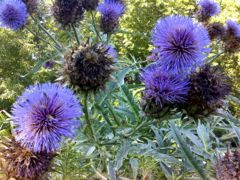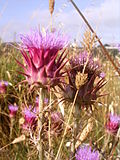Cardoon
| Cardoon {{{status}}} Fossil range: {{{fossil_range}}}
| ||||||||||||||||||||||||||||||||||||||||||||||||||||||||||||||||||
|---|---|---|---|---|---|---|---|---|---|---|---|---|---|---|---|---|---|---|---|---|---|---|---|---|---|---|---|---|---|---|---|---|---|---|---|---|---|---|---|---|---|---|---|---|---|---|---|---|---|---|---|---|---|---|---|---|---|---|---|---|---|---|---|---|---|---|
 Cardoon in flower | ||||||||||||||||||||||||||||||||||||||||||||||||||||||||||||||||||
| Plant Info | ||||||||||||||||||||||||||||||||||||||||||||||||||||||||||||||||||
| ||||||||||||||||||||||||||||||||||||||||||||||||||||||||||||||||||
| Scientific classification | ||||||||||||||||||||||||||||||||||||||||||||||||||||||||||||||||||
| ||||||||||||||||||||||||||||||||||||||||||||||||||||||||||||||||||
| [[{{{diversity_link}}}|Diversity]] | ||||||||||||||||||||||||||||||||||||||||||||||||||||||||||||||||||
| {{{diversity}}} | ||||||||||||||||||||||||||||||||||||||||||||||||||||||||||||||||||
| Binomial name | ||||||||||||||||||||||||||||||||||||||||||||||||||||||||||||||||||
| Cynara cardunculus L. | ||||||||||||||||||||||||||||||||||||||||||||||||||||||||||||||||||
| Trinomial name | ||||||||||||||||||||||||||||||||||||||||||||||||||||||||||||||||||
| {{{trinomial}}} | ||||||||||||||||||||||||||||||||||||||||||||||||||||||||||||||||||
| Type Species | ||||||||||||||||||||||||||||||||||||||||||||||||||||||||||||||||||
| {{{type_species}}} | ||||||||||||||||||||||||||||||||||||||||||||||||||||||||||||||||||
| {{{subdivision_ranks}}} | ||||||||||||||||||||||||||||||||||||||||||||||||||||||||||||||||||
| [[Image:{{{range_map}}}|{{{range_map_width}}}|]] | ||||||||||||||||||||||||||||||||||||||||||||||||||||||||||||||||||
| Synonyms | ||||||||||||||||||||||||||||||||||||||||||||||||||||||||||||||||||
| {{{synonyms}}} |
Template:Nutritionalvalue The cardoon (Cynara cardunculus), also called the artichoke thistle, cardone, cardoni or cardi, is a member of the thistle family related to the Globe artichoke. While the flower buds can be eaten much as the artichoke, more often the stems are eaten after being blanched by being wrapped or buried in earth. Battered and fried, the stems are also traditionally served at St. Joseph's altars in New Orleans.
Cardoon stalks can be covered with small, nearly invisible spines that can cause substantial pain if they become lodged in the skin. Several "spineless" cultivars have been developed to overcome this but care in handling is recommended for all types.
-
Cardoon in its natural habitat
-
A cardoon seed
-
A cardoon flower head
-
Cardoon foliage
Cardoon requires a long, cool growing season (ca. 5 months) but it is frost-sensitive. It also typically requires substantial growing space per plant and hence is not much grown save where it is a regional favorite.
The cardoon is highly invasive and is able to adapt to dry climates. It has become a major weed in the pampas of Argentina and California; it is also considered a weed in Australia.
Cardoon has attracted recent attention as a possible source of biodiesel. The oil, extracted from the seeds of the cardoon, and called artichoke oil, is similar to safflower and sunflower oil in composition and use.[1]
References
- ↑ "Plant Oils Used for Bio-diesel". BDPedia.com, the Biodiesel WWW Encyclopedia. Retrieved on 2006-11-18.
External links
- "Cardoon - General information". Michigan State University Extension (August 3 1999). Retrieved on 2006-11-18.
- Mrs. M. Grieve (1931). "Artichoke, Cardoon". A modern herbal. Botanical.com. Retrieved on 2006-11-18.
- "Cardoon". Wegman's. Retrieved on 2006-11-18.
- Mark S. Harris (January 15 2005). "Period artichokes. Recipes. Cardoons.". Retrieved on 2006-11-18. A collection of recipes from various computer networks.
- "Cardoon photo". Flickr. Retrieved on 2006-11-18.
- Template:Cite news



